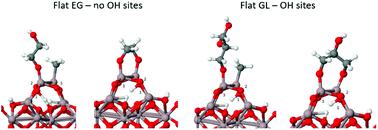当前位置:
X-MOL 学术
›
Dalton Trans.
›
论文详情
Our official English website, www.x-mol.net, welcomes your feedback! (Note: you will need to create a separate account there.)
First principles study of reactions in alucone growth: the role of the organic precursor.
Dalton Transactions ( IF 4 ) Pub Date : 2020-06-18 , DOI: 10.1039/d0dt01376e Arbresha Muriqi 1 , Michael Nolan 1
Dalton Transactions ( IF 4 ) Pub Date : 2020-06-18 , DOI: 10.1039/d0dt01376e Arbresha Muriqi 1 , Michael Nolan 1
Affiliation

|
Organic–inorganic hybrid materials are a unique class of materials with properties driven by the organic and inorganic components, making them useful for flexible devices. Molecular layer deposition (MLD) offers novel pathways for the fabrication of such hybrids by using inorganic metal precursors and the vast range of organic molecules with tunable properties. To investigate and understand the mechanism of growth a combination of theoretical and experimental data is needed. In this contribution, we present a first principles investigation of the molecular mechanism of the growth of hybrid organic–inorganic thin films of aluminium alkoxides, known as “alucones” grown by MLD. We explore the interactions between precursors by analyzing the MLD reaction products of the alumina surface terminated with Al(CH3) groups after the trimethyl aluminium pulse; this yields monomethyl-Al2O3 (Al-CH3-Al2O3) and dimethyl-Al2O3 (Al(CH3)2-Al2O3) terminated surfaces. The organic precursors are ethylene glycol (EG), diethylene glycol (DEG), triethylene glycol (TEG) and tetraethylene glycol (FEG). A detailed comparison with alucones grown with ethylene glycol (EG) and glycerol (GL) precursors is presented to assist the interpretation of experimental findings regarding the differences in the hybrid films grown by EG and GL. The results show that Al–O formation with release of methane is favorable for all precursors. EG and GL can lie flat and create so-called double reactions through the reaction of the two terminal hydroxyl groups with the surface fragments. This phenomenon removes active hydroxyl sites for EG. However, for GL the third hydroxyl group is available and growth can proceed. This analysis shows the origin of differences in thickness of alucones found for EG and GL.
中文翻译:

反应在葡萄糖醛酮生长中的首要原理研究:有机前体的作用。
有机-无机杂化材料是一类独特的材料,其性能受有机和无机成分的驱动,使其可用于柔性设备。分子层沉积(MLD)通过使用无机金属前驱物和范围广泛的具有可调特性的有机分子,为制造此类杂化物提供了新颖的途径。为了研究和理解生长机理,需要将理论和实验数据相结合。在这项贡献中,我们提出了对烷氧基铝有机-无机杂化薄膜(称为MLD生长的“铝酮”)生长的分子机理的第一个原理研究。我们通过分析以Al(CH 3)终止的氧化铝表面的MLD反应产物来探索前体之间的相互作用)三甲基铝脉冲后的基团;得到单甲基-Al 2 O 3(Al-CH 3 -Al 2 O 3)和二甲基-Al 2 O 3(Al(CH 3)2 -Al 2 O 3)端接的表面。有机前体是乙二醇(EG),二甘醇(DEG),三甘醇(TEG)和四甘醇(FEG)。提出了与由乙二醇(EG)和甘油(GL)前体生长的葡糖醛酮的详细比较,以帮助解释关于由EG和GL生长的杂化膜差异的实验结果。结果表明,形成Al–O并释放出甲烷对于所有前体都是有利的。EG和GL可以放平,并通过两个末端羟基与表面片段的反应产生所谓的双重反应。这种现象消除了EG的活性羟基。但是,对于GL,可以使用第三个羟基,并且可以继续生长。该分析显示了发现的EG和GL的糊精厚度差异的根源。
更新日期:2020-06-29
中文翻译:

反应在葡萄糖醛酮生长中的首要原理研究:有机前体的作用。
有机-无机杂化材料是一类独特的材料,其性能受有机和无机成分的驱动,使其可用于柔性设备。分子层沉积(MLD)通过使用无机金属前驱物和范围广泛的具有可调特性的有机分子,为制造此类杂化物提供了新颖的途径。为了研究和理解生长机理,需要将理论和实验数据相结合。在这项贡献中,我们提出了对烷氧基铝有机-无机杂化薄膜(称为MLD生长的“铝酮”)生长的分子机理的第一个原理研究。我们通过分析以Al(CH 3)终止的氧化铝表面的MLD反应产物来探索前体之间的相互作用)三甲基铝脉冲后的基团;得到单甲基-Al 2 O 3(Al-CH 3 -Al 2 O 3)和二甲基-Al 2 O 3(Al(CH 3)2 -Al 2 O 3)端接的表面。有机前体是乙二醇(EG),二甘醇(DEG),三甘醇(TEG)和四甘醇(FEG)。提出了与由乙二醇(EG)和甘油(GL)前体生长的葡糖醛酮的详细比较,以帮助解释关于由EG和GL生长的杂化膜差异的实验结果。结果表明,形成Al–O并释放出甲烷对于所有前体都是有利的。EG和GL可以放平,并通过两个末端羟基与表面片段的反应产生所谓的双重反应。这种现象消除了EG的活性羟基。但是,对于GL,可以使用第三个羟基,并且可以继续生长。该分析显示了发现的EG和GL的糊精厚度差异的根源。


























 京公网安备 11010802027423号
京公网安备 11010802027423号